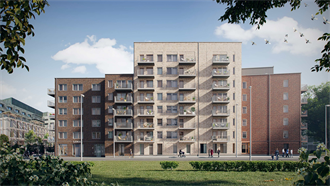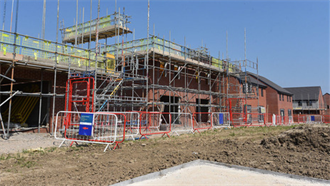Why a new 1.7 million sq ft (157,935 m2) global distribution hub for the company behind Gucci points the way to higher market performance.
Logistics Capital Partners (LCP) has become one of the largest developers of logistics property in Europe. The specialist investment firm has been placed in the top 10 logistics developers measured by completed projects in the last three years. It may rise higher still next year given its 15 million sq ft development pipeline, 8.6 million sq ft (798,966 m2) of which are pre-let projects.
One of the most eye-catching projects is a 1.7 million sq ft (157,935 m2) global distribution facility in Italy for French luxury retail group Kering. Located in Trecate near Novara in northern Italy, LCP Trecate XXL was recorded as the largest pre-let in Europe in 2019 according to industry data. The first of two buildings for Kering is fully operational, with the second set to open in Q2 this year.
As a tenant, Kering has a certain cache. Founded 57 years ago by Francois Pinault, the Paris-based conglomerate was formerly known as Pinault-Printemps-Redoute (PPR). The company owns venerable brands Gucci, Yves Saint Laurent, Boucheron, Alexander McQueen, and Bottega Veneta. Last year, it turned over €13 bn from sales of such branded merchandise.
LCP’s massive pre-let to this group in Italy is interesting not only for its largesse but also because it marks a number of fashionable trends in the global and European logistics market.
‘It really epitomizes the trend for occupiers to consolidate their supply chains into larger, more technically complex, greener hubs,’ said LCP co-founders Kristof Verstraeten and James Markby, who set the firm up five years ago.
Kering has consolidated around a dozen older facilities in Italy and adjoining European countries to centralise around this new hub from which merchandise from its top brands will be distributed.
The buildings cost well over £150 mln in construction and land costs. But what is on the inside costs practically in the same region because the tenant has installed expensive automation and systems to boost throughput and overall efficiency through economies of scale.
Flexibility throughout
The contract to develop this facility resulted from a tender organised by Kering and New York Stock Exchange-listed XPO Logistics. Before the tender materialised, LCP had already identified the ultimately successful site in this Novara region, so there was an element of ‘matchmaking’ when LCP was invited to tender.
The region of Novara is around 40 minutes from fashion capital of the world, Milan. It has transport links in all directions and a sizeable labour pool. The A4 Milan-Turin-Venice motorway is the main road link. Beyond Milan is Malpensa airport. Further north lies the Italian/Switzerland’s border. To the south west is Turin and France to the east.
No wonder Novara is a recognised logistics hub. However, LCP’s site itself would not necessarily have featured in any research report into the regions logistics hotspots, despite it being only 7 km from Novara and 7 km from the A4 and yet closer to Milan. There is direct access to the Novara ring road and SP11.
It is one of those sites that others might have passed over as perhaps not being an immediately obvious location from a technical standpoint. But as with many sites across Europe, LCP put its in-house engineers and technical experts into action and the company grew in conviction this site could one day become a winner. As soon as Kering’s tender offer materialised, LCP knew what it was destined to become.
As a side note, Markby explained that land banking is not how LCP started out. To the contrary, it is proud of its 60% pre-let statistics. Typically, the company will secure a site rapidly if an opportunity for a pre-let arises. However, over the past two years it has been assembling speculative sites that might still become the subject of a pre-let. There are two reasons for this evolution, said the founders. One is that land has become in shorter supply in Europe, so it makes sense to grab good sites where possible, and secondly, LCP’s balance sheet has become strong enough to be able to hold sites for a longer period of time.
‘When we first started out, we were not land banking,’ explained Markby. In those instances, we were mostly buying land in a relatively short period of time in advance. We would option in advance in a short time scale or buy land back-to-back with large scale pre-lets. But in the last couple of years, we have evolved. The other 40% of our current pipeline is now part of a programme where we take larger land positions for speculative projects, which could convert to pre-lets in the future, but don’t need to. It’s been an evolution.’
Verstraeten explained that at first, although Kering’s requirement was big, the project appeared somewhat standard in important aspects such as sustainability.
However, as LCP, Kering and XPO got deeper into talks, so the project became bigger, more ambitious and complex. Gradually more retail brands in Kering’s empire were brought into the equation as it sized up the potential for greater efficiencies.
Full supply chain analysis led to decisions on greater investment in automation. As well as consolidating brands, there were discussions about wanting to move certain administrative functions. As everything started to point to this becoming a global distribution centre, so things further escalated. The client’s sustainability team took interest to the point that the group wanted this global hub to be a world class sustainable property – not the industry standard LEED gold but LEED platinum – in what would be the highest rating-certified logistics building in Italy, possibly Europe, said LCP.
Energy-positive
To achieve this, the best and most advanced specifications for all parts of the buildings and their electrical and mechanical systems are being used. The buildings are using technology to heat and cool the premises via heat-pumps using geothermal wells, and the entire surface of the roof will be used for solar panels, allowing Kering to also supply stores and other sites with electricity generated in Trecate.
‘We are developing a building that can produce significantly more energy than it consumes,’ said Verstraeten.
The commercial impact of a large tenant seeing economies of scale via a super hub was clear to see. Storing and sorting more merchandise requires big investment in automation. At some point, the size of the contemplated investment reached tipping point. Instead of taking a lease of say five years, talks focused on reaching better terms on a longer lease, in this case 15 years with options to extend.
The large investment in sustainable energy becomes a very positive factor. If a tenant can produce surplus energy, it can strike a deal with a local power distributor that can lead to cost savings elsewhere, which in turn can be allocated back to the new investment in the form of even higher spec automation and systems.
From the developer’s perspective it makes a difference too. Verstraeten said: ‘For a developer it is very difficult to make that step from gold to LEED platinum on a standalone basis as the numbers won’t stack up. Developers would have to charge a higher rent, but then are you going to get that higher rent? But when you are working with a tenant, the whole dynamic changes.’
At this project, the developer and tenant are aiming for 100% usage of the roof for solar panels. At peak times, it could produce a lot more energy than the buildings need to consume. The surplus energy can be fed into the power network and means tenants can negotiate terms with electricity suppliers to supply its other premises on favourable terms.
This is something that is being explored by more and more large occupiers including retailers. ‘These big pre-let projects allow developers to go further in terms of validating the level of LEED platinum rating buildings and the level of clean energy,’ said Markby. ‘These are the types of development that are going to drive market performance and specifications.
‘It has growth implications not just for the end-user but more so for corporate occupiers everywhere. It means we can have a wider clean energy impact in the world. If we also consider the whole of LCP’s development pipeline, and extrapolate our total potential solar energy output, we could generate enough clean power annually for 45,000-50,000 people. That is more than just a fringe benefit, it is a real positive social benefit of our activity.’
At Trecate, the first of two buildings have become operational. The footprint of LCP’s site meant the whole 1.7 million sq ft (157,935 m2) requirement has to be staged in two buildings. The second will open shortly this year and it could be connected to the first via automation.
This may not even be the end of the story for this site. LCP has control of further adjoining land that will likely be of interest to business partners to Kering or possibly other logistics operators. This location could blossom from a new micro location to a very established logistics magnet.


































